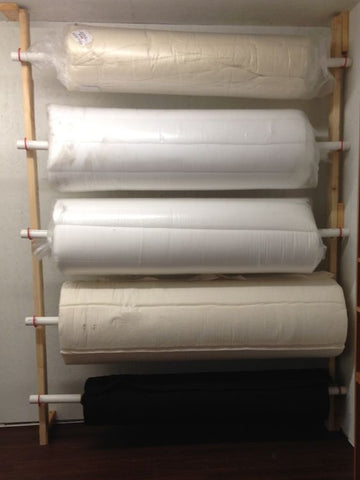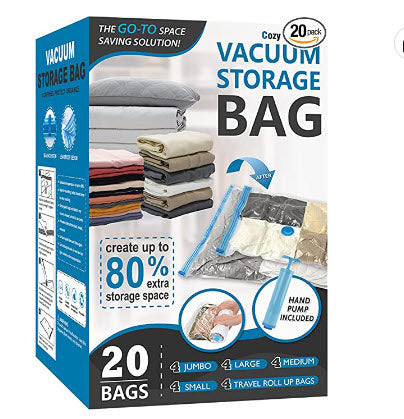When it comes to quilting, in the hoop projects, and other projects done on an embroidery machine, selecting the appropriate batting is essential to achieve the desired outcome. Batting refers to the layer of material placed between the quilt top and backing fabric, providing insulation, loft, and stability to the project. Here are some different types of batting commonly used for these projects:
-
Cotton Batting: Cotton batting is a popular choice for quilting projects. It is made from natural cotton fibers and offers a soft and breathable feel. Cotton batting provides a traditional, flat appearance and is suitable for both hand and machine quilting. It tends to shrink slightly after washing, giving the quilt a classic crinkled look.
-
Polyester Batting: Polyester batting is made from synthetic fibers and is known for its resiliency and loft. It provides a fuller appearance and maintains its shape well over time. Polyester batting is often used for high-loft projects like bedspreads or decorative quilts. It is machine washable and non-allergenic, making it a suitable choice for those with allergies.
-
Wool Batting: Wool batting is crafted from natural sheep's wool and offers excellent insulation and breathability. It has a lightweight and lofty feel, providing a fluffy appearance to quilts. Wool batting is warm and cozy, making it ideal for cold climates. It is also naturally fire-resistant and resistant to mold and mildew.
-
Bamboo Batting: Bamboo batting is a relatively newer option that has gained popularity due to its eco-friendly nature. It is made from natural bamboo fibers and offers a soft and silky feel. Bamboo batting has excellent moisture-wicking properties, making it suitable for hot or humid climates. It is typically lightweight and provides a good drape to quilts.
-
Fusible Batting: Fusible batting has a layer of adhesive on one side, which allows it to be fused or ironed onto the fabric. It eliminates the need for pinning or basting the layers together and is especially useful for in the hoop projects done on an embroidery machine. Fusible batting provides stability to the project and prevents shifting during the embroidery process.
-
Pre-cut Batting: Pre-cut batting is available in various shapes and sizes to fit specific projects, such as quilt blocks or in-the-hoop designs. These pre-cut pieces save time and effort by eliminating the need to trim the batting to size.
When choosing batting for quilting or in-the-hoop projects, consider factors such as the desired loft, warmth, drape, ease of quilting, and the project's intended use. It's also essential to follow the manufacturer's recommendations for care and washing instructions.
But why do we need batting in the Embroidery Studio ? What projects uses Batting?
- In-the-Hoop Quilt Blocks: In-the-hoop quilt blocks often incorporate batting to create the traditional quilt sandwich. The embroidery machine stitches the quilt block design, including the decorative stitching and quilting, while also securing the batting and backing fabric in place.
- In-the-Hoop Coasters: Coasters made in the hoop may include batting to provide thickness and insulation. The embroidery machine stitches the coaster design and then encloses the batting within the fabric layers, ensuring a stable and absorbent coaster.
- In-the-Hoop Potholders: Potholders made in the hoop typically utilize batting to offer heat resistance. The embroidery machine stitches the potholder design, often incorporating quilting stitches, and securely encases the batting between the fabric layers to provide thermal protection.
- In-the-Hoop Mug Rugs: Mug rugs are small fabric mats used to place cups or mugs on, similar to coasters but slightly larger. In-the-hoop mug rugs may include batting to add thickness and cushioning. The embroidery machine stitches the design, incorporates quilting stitches, and encloses the batting between the fabric layers.
- When creating bags and zipper bags in-the-hoop, batting is often used to provide structure, stability, and a soft padded feel to the finished product
- When batting is used in combination with specialized quilting designs and techniques, it can create a 3D effect similar to trapunto.
These are just a few examples of in-the-hoop projects where batting is commonly used. The type and thickness of batting can vary depending on the desired effect and functionality of the project.
Common names you might have heard about in for batting are :
- Warm & Natural
- Hobbs
- Fairfield
- Pellon
- Quilter's Dream
- Mountain Mist
- Bosal
- Legacy by Pellon
- The Warm Company
- Air Lite to name just a few.
It's important to note that different batting brands may have their own range of thickness options, allowing for more flexibility in choosing the right batting thickness for specific projects. Consider the intended use, desired appearance, quilting techniques, and practical considerations when selecting the appropriate batting thickness for your project.
When you choose batting for your project take into consideration, the loft and appearance you want, how warm or insulated does it need to be, how much stitching or quilting will go on top. Do you need the project to be flexible or have drapability? You will soon find that you have 2 or 3 different ones that you really like working with and will stick with those.
I personally have a thin low loft for bags, zipper bags and small projects, a medium loft for quilting, a high loft for more decorative, dimentional pillows or wall hangings, iron on batting when I am working with a difficult fabric type, and a heat resistant batting (Insul-Bright) when I make anything that need to withstand high heat, like pot holders and oven gloves.
Storing batting efficiently can help save space and keep your supplies organized. Here are some ideas on how to store batting to maximize space:
If you are a camper, you will immediately recognize these hanging shelves - you can hang these in a cupboard, or in a corner, under a table (You get some that are only 3 shelves high) - then neatly store your batting in those - View some options HERE and another option here - you can cut your batting into smaller sizes you use most often to make storing them easier than a bulky roll.
Another option are these reusable vacuum storage bags, cut your batting into single bed size or larger if you make large bed quilts) and vacuum seal each one on their own, not only do they stay clean and dry but organized and you can take out as you need without the hassle of unrolling and cutting a big roll.
For those that uses a lot of batting very often or make a lot of bed quilts, and permitted you have the space, a batting stand will do wonders !!
You can easily make these yourself with PVC pipes, the roll of batting easily slides over the pipe and hand on the shelve. Remember though to always cover with plastic, especially if you store these in a basement or high moist area.

Other Ideas, include :
- Fabric Bolts: Repurpose sturdy fabric bolts or cardboard tubes to wrap the batting around. This method provides stability and prevents the batting from unraveling. Label the bolts for easy identification and stack them vertically or in a storage bin.
- File Storage Boxes: Use file storage boxes or plastic containers with lids to store folded or trimmed batting pieces. Fold the batting neatly and place it inside the box. This method keeps the batting protected and allows for easy stacking on shelves or in closets.
- Under-Bed Storage: Utilize under-bed storage containers or bags to store batting rolls or folded pieces. This maximizes space and keeps the batting easily accessible while keeping it out of sight.
Just remember to always Choose a clean, dry storage location away from dampness and moisture. If you can avoid basements, attics, or areas prone to humidity. Ensure the storage space is well-ventilated to prevent condensation.
Place moisture-absorbing products, such as silica gel packets or moisture-absorbing crystals, inside the storage containers. These help to maintain a dry environment and reduce the risk of mildew or mold growth.
Protect your batting from insects by using natural deterrents. Add lavender sachets or cedar chips to the storage containers to repel moths and other insects. These natural options provide a pleasant scent while keeping pests away.
In our next installment on the Makeover Extravaganza, we will start to concentrate on the smaller items in the Sewing room, needles and haberdashery, then moving over to fabric markers, rotary cutters and scissors and so on. We will provide you with different options not only for storage but showing you different products and options you might not know about or want to explore but just not sure what it does.












4 comentarios
Sue Bierly
Very informative info from Stitch Delight and comments. Storage ideas are great for my small area. Thank you. Have a safe and happy holiday.
JuDee Clark
Thank you for all of the information. I have Very Limited space and appreciate any ideas on effective methods of storage. This “hobby” tends to invade most areas of my home!! But I love it.
Margaret Ray (Kestenbaum)
I store my large roll of Matilda’s Own 60% wool 40% polyester batting on the wheelie base of an office chair reclaimed from a neighboughood curbside. The large heavy duty tube in the centre of the roll just slips over the chair spindle after the chair seat and mechanism has been removed. Because the roll sits vertically on the wheels, it takes up less storage space. I just measure and cut the batting straight down the roll with batting shears, easy peasy! This is a great recycle option, at no cost.
Chalice
So informative, really enjoy reading about everything.
Thank you